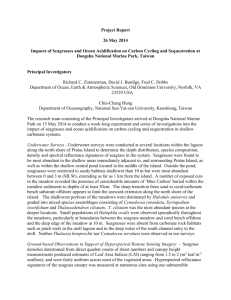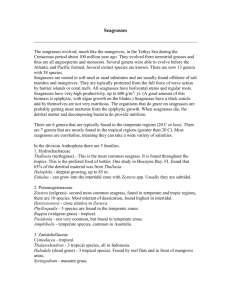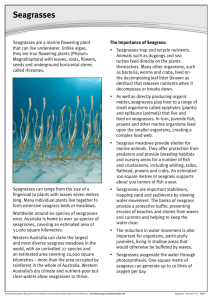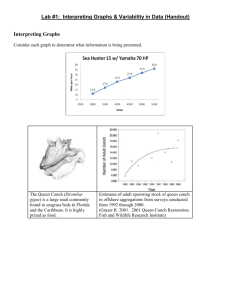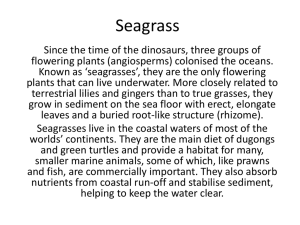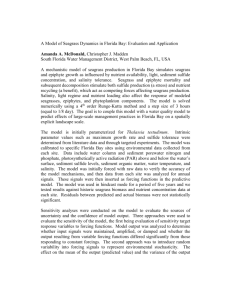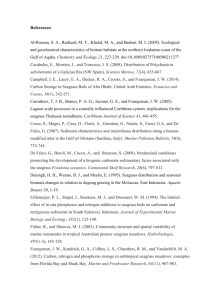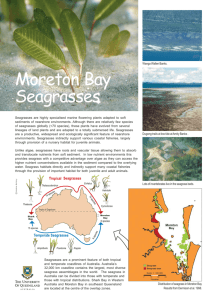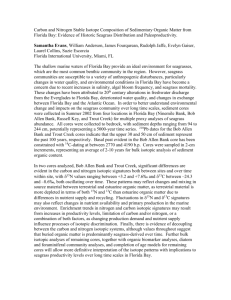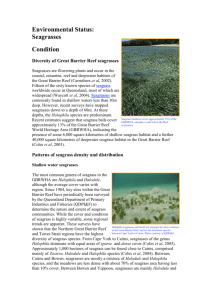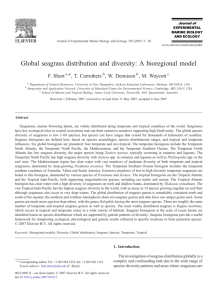Seagrass Awareness
advertisement
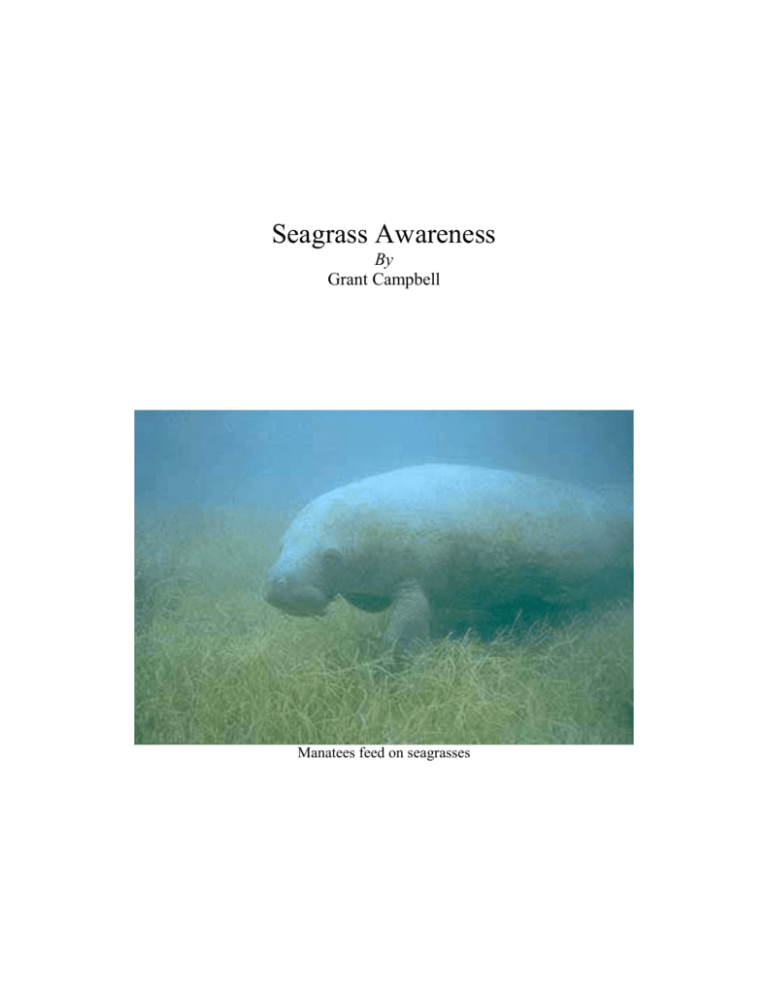
Seagrass Awareness By Grant Campbell Manatees feed on seagrasses Florida Governor Charlie Crist proclaimed March as Seagrass Awareness Month In March of 2007. It's a shame that it should take a proclamation to raise awareness about seagrass; every month should be Seagrass Awareness Month because seagrasses provide a nursery area for myriad species of marine fish and shellfish. Endangered Johnson's seagrass Some varieties of seagrass such as Halophila Johnsonii, or Johnson's Seagrass, are protected by the US Fish and Wildlife Service and by the Endangered Species Act. Johnson's Seagrass plays a major role in the health of benthic resources as not only a shelter and nursery habitat, but it has also been documented as a food source for endangered West Indian manatees and threatened green sea turtles. NOAA's National Marine Fisheries Service (NMFS) continues to conduct ecological research on Johnson's seagrass to better understand its life history and to make informed conservation decisions affecting the seagrass ecosystems. Seagrasses give protection and hiding spaces for the fry of shallow water as well as deepwater species, from the larval to the juvenile stage and act as a refuge for adolescent fishes, turtles, shrimp, lobster and many varieties of bait fish. Many species of juvenile fish use seagrass beds as nurseries Seagrasses grow in the shallows and are highly susceptible to damage by vessel grounding, anchor dragging, propeller scarring, dredging and filling activities and intentional abuse. Florida's seagrass communities support at least six commercially viable fish species, and without the protection of the seagrass, most of these fishes would not reach maturity. Florida's fishing industry would virtually cease to exist. Scarring in turtle grass Deliberate scarring Johnson's seagrass has a very limited distribution; it is the least abundant seagrass within its range. It has a patchy distribution along the east coast of Florida from central Biscayne Bay to Sebastian Inlet. The largest patches have been documented in the Lake Worth Inlet. The southernmost distribution is reported to be in the vicinity of Virginia Key in Biscayne Bay. Johnson's seagrass is the rarest species of its genus. It has a limited ability to disperse and colonize habitats because of its asexual reproduction, and is dependent on substrate stability. Quantitative data on the species are rare, though one study found that abundance of all seagrass species is 16% less than in 1986 for the entire Indian River Lagoon complex (Ponce to Jupiter Inlet). Longer-term losses are thought to be approximately 50% for all seagrasses since the 1970s (Woodward-Clyde 1994). Continued existence and recovery of Johnson's seagrass may be limited due to habitat alteration by a number of human and natural disturbances. 1.) Alteration and subsequent destruction of the benthic community from boating activities, propeller scarring of the substrate, anchoring, and mooring has been observed in Johnson's seagrass sites. Such activities result in broken root systems, severed rhizomes, and significant reductions of the physical stability of the substrate. 2.) Dredging waterways for boat access redistributes sediments, buries plants and destroys bottom topography. 3.) Erosional forces and sedimentation associated with severe storms are likely to affect some populations located near inlets. During hurricanes, storm surge may scour and redistribute sediments eroding or burying existing populations. Siltation due to human disturbance and land-use practices can also threaten viability of the species. 4.) Nutrient enrichment, caused by inorganic and organic nitrogen and phosphorus loading via urban and agricultural land run-off, can stimulate increased algal growth and smother Johnson's seagrass by shading rooted vegetation and diminishing the oxygen content of the water. Research is continuing on ways to successfully grow the species in captivity and transplant it to suitable locations. The recovery plan also calls for research on basic reproductive biology and life history of the species as well as general management and coordination among responsible local, state, and Federal agencies. As important and as rare as Johnson's Seagrass is, it is not the only seagrass that falls under these parameters. All seagrasses provide nursery habitat and all are subject to the same perils. Seagrasses are flowering plants that live underwater, but the depth at which they are found is limited by water clarity because they require light. Like land plants, seagrasses produce oxygen and contribute to the oxygen content in the water that fish depend upon. Although seagrasses occur throughout the coastal areas of the state, they are most abundant from Tarpon Springs northward to Apalachee Bay. Seagrasses occur in protected bays and lagoons and also in places along the continental shelf in the Gulf of Mexico. Florida's estimated 502,000 acres of seagrasses are important natural resources that perform many significant functions: 1.) They help maintain water clarity by trapping fine sediments and particles with their leaves. 2.) They can stabilize the bottom with their roots and rhizomes in much the same way that land grasses retard soil erosion. 3.) They provide habitat for many fishes, crustaceans, and shellfish. 4.) Seagrasses and the organisms that grow on them are food for many marine animals. Although approximately 52 species of marine seagrasses exist worldwide, only seven species are found in Florida waters. Four of these are widespread in Florida and extend beyond its borders. The other three are species of Halophila: star grass (Halophila engelamannii), paddle grass (Halophila decipiens), and Johnson's seagrass (Halophila johnsonii). Florida's Seagrasses Although approximately 52 species of marine seagrasses exist worldwide, only seven species are found in Florida waters. Four of these are widespread in Florida and extend beyond its borders. Shoal-grass (Halodule wrightii) is an early colonizer of disturbed areas and usually grows in water too shallow for other species. Ruppia maritima, commonly called widgeon-grass, grows in both fresh and saltwater and is widely distributed throughout Florida's estuaries. Turtle-grass (Thalassia testudinum) the most common Manatee-grass (Syringodium filiforme) is of the Florida seagrasses, characteristically has deeper easily recognizable because its leaves are root structures than any of the other seagrasses. cylindrical. star-grass (Halophila paddle-grass (Halophila decipiens) Johnson's seagrass engelmannii) (Halophila johnsonii) The other three are species of Halophila: star grass (Halophila engelamannii), paddle grass (Halophila decipiens), and Johnson's seagrass (Halophila johnsonii). These small, fragile seagrasses are sparsely distributed in Florida and only limited information about them exists. http://www.nmfs.noaa.gov/habitat/habitatprotection/hptype/hptype1.htm Seagrasses are disappearing at an alarming rate. Dredge and fill projects and degraded water quality, as well as other activities, are responsible for their precipitous decline. By analyzing aerial photographs from 1940's and 1950's and satellite imagery and aerial photographs from the 1980's on, the scientists are able to evaluate habitat change. During the past 100 years, Tampa Bay has experienced an 81 percent decline in seagrass acreage. A 29 percent decrease in area of Charlotte Harbor seagrasses was documented through comparison of aerial photographs from 1944 to 1982. At the Ponce Inlet site, a 100 percent loss of seagrasses was noted. This destruction was due primarily to dredge and fill activities for development and the Intracoastal Waterway. A seven-mile stretch of estuary surrounding the Sebastian Inlet has experienced a 38 percent decline in seagrass habitat since 1951. In another study site just north of Fort Pierce Inlet a 25 percent loss of seagrasses was documented since 1958. (http://www.floridadep.org/coastal/habitats/seagrass/) Damage of this nature lasts for years As part of an investigation begun in December, Swiftmud on Friday, March 21, 2008, photographed this SunCruz casino boat stirring up mud and sea grass off the Pasco-Hernando coast. These studies are increasing public awareness about the problem of fisheries habitat losses and are providing incentive to address this serious problem in Florida's coastal zone, but much more public education is needed to raise the awareness of the benefits of seagrass.
